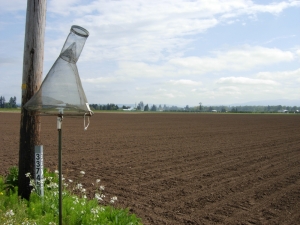Authors: Pamela Opfer and Dan McGrath, OSU Dept. of Horticulture
Bertha Armyworm (Mamestra configurata)


Bertha Armyworm larvae Bertha Armyworm adult moth (Photos by Ken Gray)
How to ID Pest
The adult moth is a greenish-gray or gray moth with two spots on the forewings, a small round spot with a large kidney-shaped white or gray spot on the middle of the wing, and a whitish band near the fringe of the wing. Larvae are about 40 mm long when mature. The head is pale brown with or without dark arcs and reticulations, and with an inverted white "Y". The color of the larvae varies from green to gray, brown, or black. The mid-dorsal and top-lateral lines are white, broken and inconspicuous. The inverted white “Y” does not become very noticeable until the larvae are mature, in the fifth and sixth instar.
Lifecycle
Bertha armyworm overwinters as a pupa in the soil. Adults emerge in mid-Spring, and the females lay eggs in masses on the underside of leaves of crop plants and weeds (particularly lambsquarters). Eggs hatch in 4 to 8 days. Larvae dangle from the plant by threads of silk until they reach other leaves or are blown by the wind to other plants, where they begin feeding. Thus infestations of bertha armyworm tend to occur in patches fairly close to where the eggs were deposited. Sometimes the larvae will remain on a single plant where they were laid. Larvae feed for 5 to 6 weeks in June and July. In their late stages (fifth and sixth instar) the larvae disperse. This is why they call them “armyworms”. Bertha armyworm pupate in the soil. In the Willamette Valley, some of the adults emerge from the soil during mid- to late July and begin a second generation in August. Damage caused by these larvae is noticeable in mid-August and September. There are two overlapping generations each year.
Crops Affected & Damage
Armyworm damage on cole crops appears as skeletonized leaves with only leaf veins and petioles remaining. When infestations become dense and crowded, larvae migrate together from field to field; migrating armyworms may completely defoliate crops. Bertha armyworms have been a serious problem in bell peppers grown for processing. In an outbreak, Bertha armyworms attach a wide variety of crops including small grains.

Crop damage from larvae (Photo by Dan McGrath)
Scouting & Monitoring
Bertha armyworm “strikes” are single plants or small clusters of plants that have many worm holes. It is difficult to detect Bertha armyworm using standard scouting methods. Armyworm strikes are widely scattered across a given field. What we recommend as the scout crosses a field pulling and examining leaves, they should stop every ten leaves and scan for armyworm strikes. If they see a plant or a small grouping of plants with a lot of holes in the leaves, they should examine the plant for armyworm. It is difficult to detect adult moth egg laying events. The standard paper wing trap generally does a poor job of picking up armyworm flights. Instead, we recommend the use of the Texas style wire mesh trap. It is highly sensitive and will capture Bertha armyworm moths. The commercially available pheromone for Bertha will attract other cutworm species including the Variegated Cutworm (Peridroma saucia) so it is important to learn to recognize and pick out the Bertha armyworm moth. It will occur at low densities. Any detection of Bertha armyworm egg laying should prompt careful field scouting and conservative spray decisions.
Wire Cone Trap (photo by Pamela Opfer)
Risk Assessment & Interpreting Flight Data
Any detection of Bertha armyworm moths in pheromone traps should be taken seriously and that larval populations will follow. If on average, you detect more than one moth per trap per day, it is a significant egg laying flight (See Graph One). On average, if one or more larvae or egg masses are found during your scouting, treatments may be justified.

Control Methods
Biological Control: Bertha armyworm populations are ofetn kept in check by such factors as weather and natural enemies.
Cultural Control: Weed control is important. Lambsquarters and wild mustard attract egg-laying females and provide a source of food for larvae. Fall tillage can also help destroy overwintering pupae.
Chemical Control: Insecticide applications are most effective if applied against small larvae. Please consult the PNW Insect Management Handbook for pesticide recommendations.
References and Citations
Berry, Ralph E. 1998. "Bertha Armyworm Factsheet." Modified from Insects and Mites of Economic Importance in the Northwest. 2nd Ed. p. 221 Accessed December 8, 2011. (http://mint.ippc.orst.edu/berthafact.pdf).
"Bertha Armyworm Factsheet." Oregon State University. Accessed December 8, 2011. (http://insects.ippc.orst.edu/pdf/reb101.pdf).
Hollingsworth, Craig S. (Ed.). 2011. Pacific Northwest Insect Management Handbook. Corvallis: Oregon State University.

